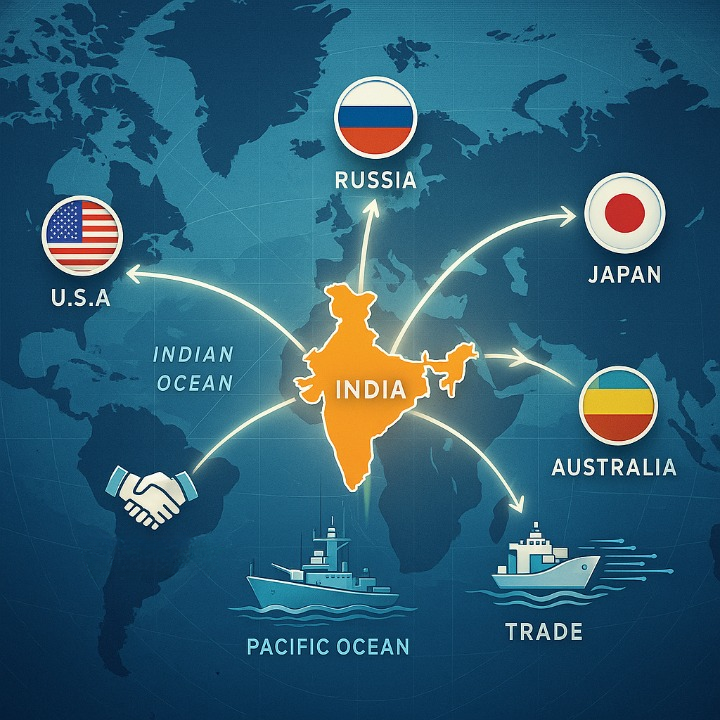
- India’s transition from non-alignment to multi-alignment thus encapsulates its new comprehension of the nature of global realities and its place within them.
- India’s Indo-Pacific strategy is rooted in its commitment to a free, open, inclusive, and rules-based regional order.
- India wants to protect its interests by using a flexible, multi-directional foreign policy that takes into account the many different interests that form the complicated global order of today.
Introduction
In the last few decades, India’s foreign policy has undergone a severe transformation. In this context, India’s more flexible, practical and multi-aligned foreign policy can be seen even more clearly since independence, when the policy of nonalignment had been the cornerstone of its international standing. A good example is its Indo-Pacific policy. Different, the larger geopolitical context of the Asia-Pacific, increasingly being referred to as Indo-Pacific, and New India’s broader global aspirations. The bringing together of the Pacific and the Indian Ocean into one strategic space, the term itself suggests an imagination for geopolitics that is broader and less exclusionary.
The Foundations of Non-Alignment
The concept of India’s non-alignment emerged during the Cold War and was pursued as a way to retain strategic autonomy and ward off involvement in the bipolar contest between the United States and the Soviet Union. Leaders such as Jawaharlal Nehru thought that nations should be free to decide their foreign relations without external compulsion and that naturally this should include freedom to associate with other nations. The Non-Aligned Movement (NAM), India being a founding member, was an expression of this ethos and aimed to inspire peace, decolonisation economic cooperation.
However, while non-alignment allowed India to maintain a degree of independence in international affairs, it also limited the country’s ability to leverage strategic partnerships for national security and economic development, especially as regional threats and global power dynamics began to shift in the post-Cold War period.
Emergence of the Indo-Pacific Concept
Early in the twenty-first century, the phrase “Indo-Pacific” became well-known, especially as China’s military and economic rise started to change the regional balance of power. First popularised by Japan and then taken up by nations including Australia and the United States, the Indo-Pacific version underlined the strategic connectivity of the Indian and Pacific Oceans. For India, this structure presented a special chance to establish its leadership as a major state in an area vital for strategic stability, marine security, and world trade. India’s Indo-Pacific strategy is rooted in its commitment to a free, open, inclusive, and rules-based regional order. This vision resonates with other democratic nations in the region, forming the basis for emerging partnerships and coalitions, such as the Quadrilateral Security Dialogue (Quad), involving India, the United States, Japan and Australia.
Multi-Alignment: A Pragmatic Shift
India’s multifarious change from its conventional policy of objectivity towards a more balanced posture shows a wise recognition of the complex geopolitics defining modern international relations. This strategic change doesn’t mean that New Delhi is completely giving up on concepts that have been important to them in the past. Instead, it shows that they are quite aware that managing a world that is becoming more diverse requires using many different ways that work well together.
Indian leaders have come up with a practical way to deal with this interconnected time of competing objectives by building a lot of strategic partnerships and without relying too much on any one group. India wants to protect its interests by using a flexible, multi-directional foreign policy that takes into account the many different interests that form the complicated global order of today.
All relationships have seen India evolve into a complex multi-alignment strategy. While relations with the U.S. are characterised by close defence collaboration and economic partnerships, relations with Russia can be characterised by energy agreements and booming trade. Historical and cultural ties with Southeast Asian countries are still strong. Meanwhile, negotiations continue in relation to issues of mutual interest with the European Union. Despite ongoing tensions over borders with China, there are still diplomatic channels between New Delhi and Beijing. At the same time, India continues to foster solid military relations with other regional-friendly states as a means to offset the balance of power against an increasingly assertive China.
Strategic Engagement in the Indo-Pacific
India’s strategic engagement in the Indo-Pacific includes several key pillars:
- Maritime Security and Naval Diplomacy: India expanded its naval presence in the Indian Ocean Region (IOR), engaging in joint exercises with partners, with the objective to secure sea lanes of communication and deter threats, whether piracy, terrorism or trafficking.
- The Quad and More: The reinvigoration and deepening of the Quad is representative of India’s readiness to work with like-minded countries on issues of common interest, such as resilience of supply chains, new technologies and climate change, etc.
- Act East Policy: Through the Act East Policy, India’s relations with ASEAN countries have also strengthened to foster economic, political, and cultural linkages as well as connectivity in the region.
- Development and Connectivity: India’s developmental diplomacy is reflected in initiatives like the Indo-Pacific Oceans Initiative (IPOI) and projects like the India-Myanmar-Thailand Trilateral Highway.
Challenges and the Road Ahead
India does have a few challenges, but despite its increasing role in the Indo-Pacific region. China’s aggressive posturing across the South China Sea and the LAC is an enduring security challenge. Also, India has its aspirations within the context of domestic limitations, such as the country’s economic capacities as well as developmental imperatives.
On top of that, balancing other rival powers is a diplomatic process. For instance, India drew closer to the US strategically at the same time it engaged Russia, a partner it increasingly aligned with China around defence and energy cooperation. It remains a very complex balance, one that must not come at the cost of losing strategic autonomy.
Conclusion
India’s transition from non-alignment to multi-alignment thus encapsulates its new comprehension of the nature of global realities and its place within them. India’s “Indo-Pacific” strategy is one explicit case of how India wishes to be proactive in this constantly evolving Asian geopolitics, instead of simply responding to it. Rather than compromising its original ideals, multi-alignment can be interpreted as an attempt to recreate them, to make them fit for purpose in a world that is shifting at an unprecedented rate. In this context, as great power competition plays out in the Indo-Pacific, India’s role as a balancer and as a voice for a rule-based order will be essential not just for regional stability but for the shaping of a new global governance.
References:
- https://impact.economist.com/projects/trade-in-transition/climate_change/
- https://www.orfonline.org/expert-speak/india-developing-economic-ties-indo-pacific
Megna Devkar is a Ph.D. Research Scholar at K.C. Law College with research and writing expertise in social, political, and legal issues. Views expressed are the author’s own.
